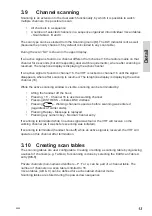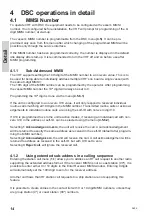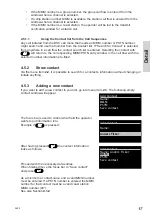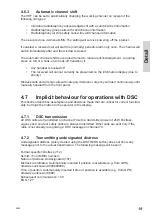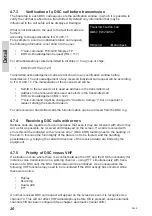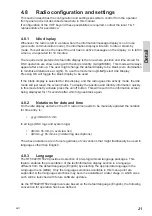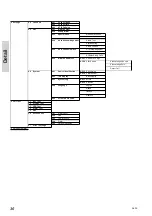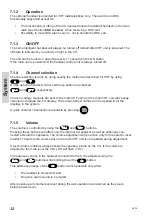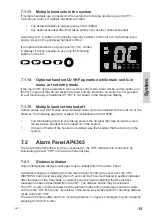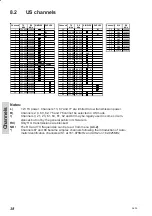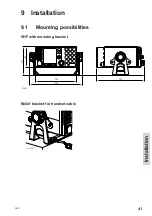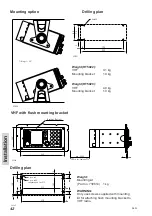
27
Detail
5.2.3
GPS
Symptom: Position requested
Possible cause/remedy: In case of the VHF, despite being connected to a GPS/position
source, prompts for entering of the position and time information the automated update has
most likely been lost either due to missing data on the line, broken cabling or the GPS/
position source has failed. Refer to the installation section in the back of this manual for
installation and connection details.
Until the automatic position update from GPS/position source is restored position and time
must be entered manually when prompted by a (four hour) timer in VHF.
In the accessory self test menu (5.6.2) the presence of postion data may be verified. If data
is present the status read out will be “connected” whereas if no data is present status read
out will be “disconnected”.
5.2.4
Accessory connection
Symptom: Some or all of the remote units do not work
Possible cause/remedy:
First turn off the VHF and then turn back on. Turn on any remote units connected to the VHF,
if possible.
Check status of the remote units from the accessories menu (5.6.x). If status read out is “not
found” for a particular device communication between this and the VHF is missing.
The communication between the VHF and the remote units is by the serial Sparc II connec-
tion at the rear of the VHF. Remote unit(s) may be connected directly to this Sparc II
connector or via the Connection Box and/or Extension Box (refer to installation section in the
back of this manual).
In case of an Alarm Panel (AP4365) being connected to the VHF check and verify that the
red “VHF DISTRSS” button in the Alarm Panel is lighted. If this is not the case check and
verify that power is available to the Alarm Panel in order for this and its serial bus to be
operational.
Any communication problems on the data bus will not otherwise affect the VHF functionality.
5.2.5
DSC routine testing
On a regular basis the DSC installation should be checked.
Verification of the complete DSC installation, with antennas, should be done by transmission
of a Safety Test call to another station (coast or ship). The test call is generated using the
DSC call flow via menu 1.4.3.2.3.
The call should normally be replied by the receiving station without questioning. The default
configuration of an RT5022 is auto-acknowledgement of any received Safety test call
requests. If a ship is equipped with multiple radios a second radio can be the station to check
up against. The transmitting RT5022/RT5020 will not receive its own transmitted calls.
If there is only a single radio on a vessel, a facility is built into the unit where the DSC engine
can be verified using a test call that is internally looped without activating the radio transmit-
ter PA. The test is executed via menu 5.5. The call sequence that is verified, is an Individual
Safety Test Call directed to own MMSI. The test status is read in the display.
0605
Содержание RT5022 VHF DSC
Страница 1: ...SAILOR RT5022 VHF DSC SAILOR RT5020 VHF DSC Duplex OPERATION MANUAL...
Страница 2: ......
Страница 66: ......
Страница 67: ......
Страница 68: ...Thrane Thrane A S info thrane com www thrane com B5022GB0 Issue L 09 02...

